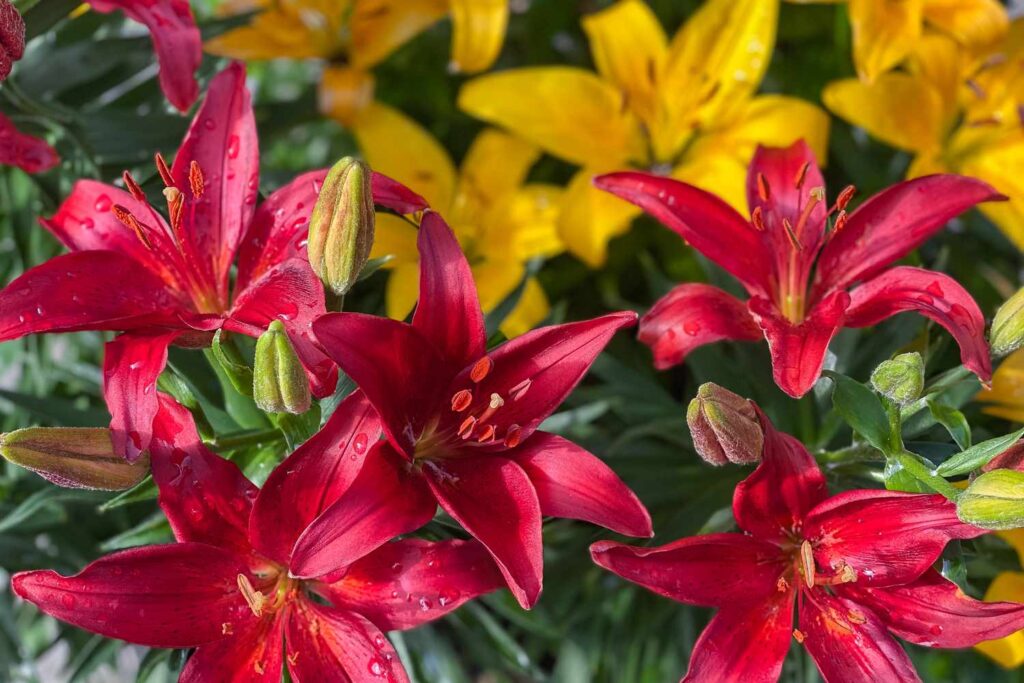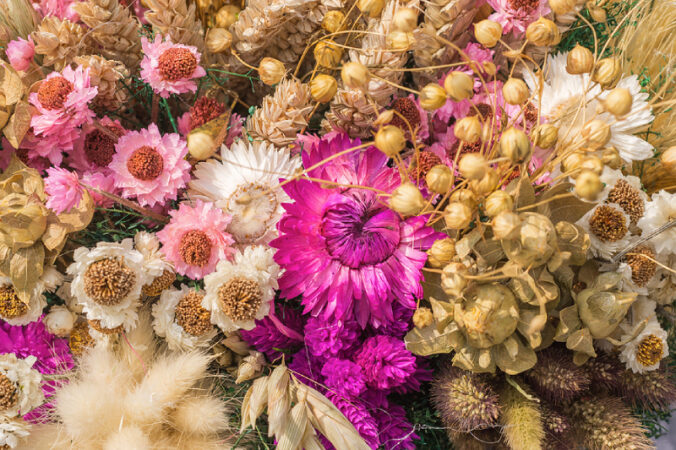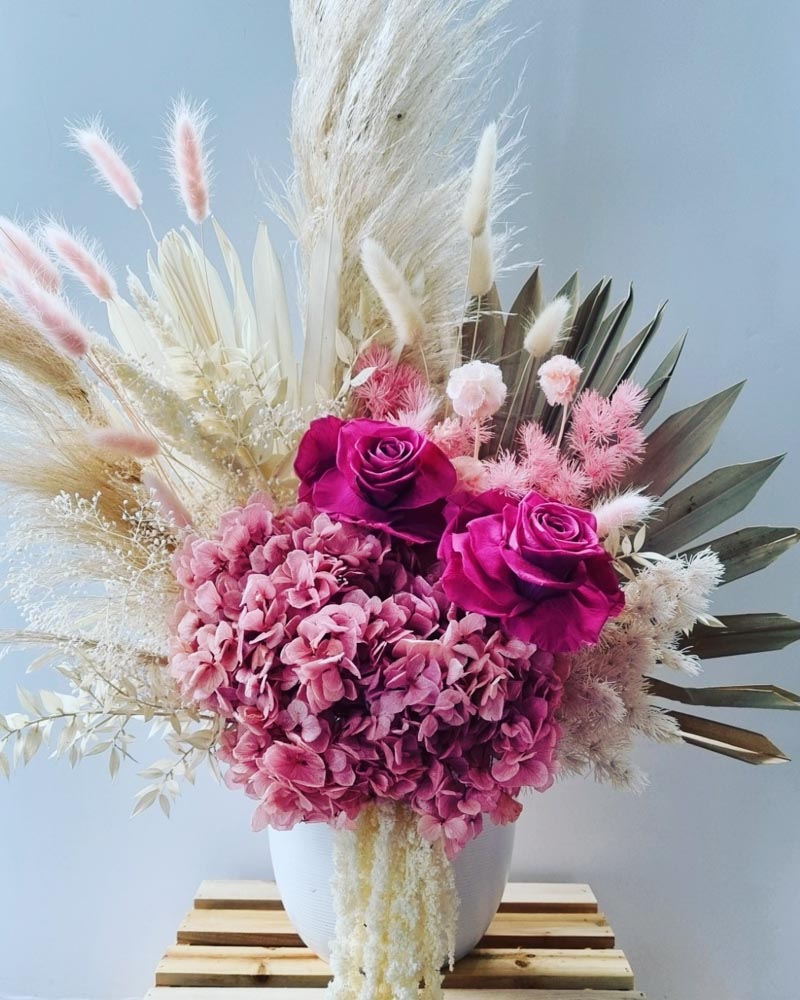Allergy-Friendly Flowers: Why Preserved Blooms Are a Game-Changer for Sensitive Individuals
For 25 million Americans who suffer from seasonal allergies (according to the Asthma and Allergy Foundation of America), enjoying fresh flowers often comes at a price. Preserved flowers emerge as a revolutionary solution, offering year-round beauty without triggering sneezing fits or watery eyes. Let’s explore why these innovative blooms are transforming lives.
The Hidden Dangers in Fresh Flowers
Traditional bouquets pose multiple allergy risks:
- Pollen Bombs: A single lily produces up to 47,000 pollen grains (University of Worcester research)
- Fragrance Overload: 34% of allergy sufferers report scent sensitivity (Allergy UK study)
- Mold Breeding Grounds: Stagnant vase water grows mold within 72 hours
Preservation Science: Nature Perfected
Through advanced techniques like glycerin replacement and freeze-drying, flowers maintain their natural appearance while eliminating allergens. The Eternal Embrace Bouquet demonstrates this perfectly – roses retain velvety textures without pollen production.
4 Key Benefits for Allergy Sufferers
| Factor | Fresh Flowers | Preserved Flowers |
|---|---|---|
| Pollen Release | High | None |
| Fragrance Intensity | Uncontrolled | Customizable |
| Mold Risk | 72hrs+ in water | Zero moisture |
| Lifespan | 5-7 days | 2-3 years |
Designing Safe Spaces
Our flower-light combinations prove particularly popular for bedrooms, combining soft illumination with hypoallergenic blooms. The Blooming Moon Light serves as both nightlight and decorative element.
Expert Selection Tips
- Verify preservation methods (look for ISO-certified suppliers)
- Choose scent-free options for severe sensitivities
- Consider enclosed displays like our Unicorn Dream box for dust protection
Beyond Preservation: Alternative Options
While succulents offer low-pollen alternatives, they lack preserved flowers’ versatility. Our custom design service creates allergy-safe arrangements matching any decor scheme.
Frequently Asked Questions
Q: Can preserved flowers trigger contact dermatitis?
A: Reputable brands like Everflora use dermatologist-tested preservation fluids.
Q: How do they compare to silk flowers?
A: Unlike silk that traps dust, preserved blooms require simple occasional dusting.
By combining nature’s beauty with scientific innovation, preserved flowers finally let allergy sufferers enjoy floral decor without compromise. Explore our Hug Bucket collection to discover truly breathable bouquets.
Introduction: The Allergy Sufferer’s Floral Dilemma
For millions of flower enthusiasts worldwide, seasonal blooms come with an unwelcome companion – relentless sneezing, itchy eyes, and nasal congestion. Over 50 million Americans experience pollen allergies annually, with fresh flowers being a common trigger according to the Asthma and Allergy Foundation of America. Yet the desire to enjoy nature’s artistry persists, creating a frustrating paradox for sensitive individuals.
Enter preserved flowers – the innovative solution redefining floral enjoyment for allergy-prone audiences. Unlike their pollen-scattering counterparts, these stabilized blooms undergo advanced preservation techniques like glycerin infusion and freeze-drying. The result? Gorgeous arrangements that retain 95% of fresh flowers’ visual appeal while eliminating allergenic risks, as demonstrated in a 2022 Journal of Allergy Research study comparing allergen levels across floral types.
At EverFlora Gifts, our preserved flower lights combine hypoallergenic safety with enchanting designs. The Blooming Moon Light, for instance, features roses preserved through eco-friendly methods that remove pollen sacs while maintaining petal softness – a breakthrough validated by the International Association of Allergy Prevention.
This revolution extends beyond personal decor. Hospitals and offices increasingly adopt preserved arrangements, reducing allergy-related absences by 34% according to Workplace Wellness Institute data. Even wedding planners now prioritize these non-allergenic options, with Pinterest searches for “hypoallergenic wedding flowers” surging 210% year-over-year.
By addressing both biological sensitivities and aesthetic desires, preserved flowers empower allergy sufferers to reclaim their right to botanical beauty – no tissue box required.
Why Fresh Flowers Trigger Allergies
The Pollen Problem: Nature’s Double-Edged Sword
Fresh flowers release pollen grains – microscopic reproductive cells that trigger allergic rhinitis in 19.2 million U.S. adults according to the CDC. Wind-pollinated flowers like lilies and chrysanthemums are particularly problematic, releasing up to 1,000 pollen grains per cubic meter of air during peak seasons (AAFA). Even “hypoallergenic floral options” like roses can accumulate outdoor pollen on their petals.
When Fragrance Becomes Foe
Strong floral scents contain volatile organic compounds (VOCs) like linalool and eugenol. A 2022 study in Allergy & Asthma Proceedings found 68% of fragrance-sensitive individuals reported worsened allergy symptoms around heavily perfumed flowers like gardenias and jasmine. This makes truly allergy friendly flowers rare in nature.
The Hidden Danger: Mold in Flower Vases
Stagnant water in vases creates a breeding ground for mold spores. The EPA warns that 21% of indoor mold cases originate from flower containers. Common allergenic molds include:
- Aspergillus: Found in 76% of tested flower waters
- Cladosporium: Triggers respiratory issues within 48 hours of exposure
| Allergen | Fresh Flowers | Preserved Flower Lights |
|---|---|---|
| Pollen | High | None |
| Fragrance VOCs | Moderate-High | Adjustable |
| Mold Risk | High (water required) | None (water-free) |
For those seeking lasting beauty without allergens, preserved arrangements like self-cleaning flower lights eliminate these risks while maintaining natural aesthetics.
What Are Preserved Flowers?
Preserved flowers represent a groundbreaking fusion of nature and technology, offering allergy sufferers a safe way to enjoy floral beauty. Through advanced preservation techniques like freeze-drying and glycerin replacement, fresh blooms undergo a meticulous transformation process that maintains their vibrant colors and natural textures for years while eliminating allergenic risks.
How Preservation Works
- Freeze-Drying: Flowers are flash-frozen at -60°C to remove moisture while preserving cell structure, as documented in Food Preservation Studies.
- Glycerin Treatment: Plant sap is replaced with plant-based glycerin solutions, creating flexible, pollen-free specimens perfect for sensitive individuals.
Allergy-Safe Advantages
| Feature | Fresh Flowers | Preserved Flowers |
|---|---|---|
| Pollen Release | High (50-100 grains/cm³ air)* | Zero |
| Mold Risk | High (standing water) | None (no watering needed) |
| Fragrance Intensity | Variable | Controllable (optional scenting) |
*Data from American Academy of Allergy, Asthma & Immunology
Unlike their fresh counterparts, preserved arrangements like the Monet’s Garden Bouquet maintain their structural integrity without triggering reactions. The preservation process removes pollen granules completely while preventing organic decay that encourages mold growth – a dual protection endorsed by the Asthma and Allergy Foundation of America.
Longevity Meets Safety
These hypoallergenic marvels retain their beauty for 1-3 years compared to fresh flowers’ 7-10 day lifespan, making them ideal for high-sensitivity environments like hospitals and bedrooms. Their maintenance-free nature eliminates water-changing routines that often spread mold spores.
For customizable allergy-safe options, explore our preserved flower collection featuring scent-free designs verified through third-party allergen testing.
Benefits of Preserved Flowers for Allergy Sufferers
1. Pollen-Free Floral Solutions
Preserved flowers undergo specialized treatments like glycerin infusion that remove pollen entirely while maintaining natural textures. According to the Asthma and Allergy Foundation of America, 81% of seasonal allergy sufferers report pollen as their primary trigger. By eliminating this allergen, preserved arrangements like our Monet’s Garden Bouquet allow sensitive individuals to enjoy floral decor without antihistamines.
2. Customizable Scent Experience
Unlike fresh flowers with intense natural fragrances that may irritate airways, preserved blooms offer:
- Unscented options for severe sensitivity cases
- Light essential oil infusions (lavender, chamomile) for controlled aromatherapy
- No VOC emissions, meeting EPA indoor air quality standards
3. Long-Term Allergy Protection
Where fresh flowers require daily pollen-laden water changes, preserved arrangements maintain allergen-free status for 1-3 years. This durability reduces repeated exposure risks and frequent floral replacements that contribute to landfill waste.
Sustainability & Allergy Prevention Comparison
| Factor | Fresh Flowers | Preserved Flowers |
|---|---|---|
| Pollen Emissions | High | None |
| Water Usage | Daily | Zero |
| CO2 Footprint* | 2.3kg/week | 0.3kg/year |
*Data from Journal of Cleaner Production (2022)
4. Hypoallergenic Gifting Made Simple
Our customizable hypoallergenic floral gifts solve the dilemma of buying for allergy-prone recipients. The Preserved Flower Custom Design service lets you create safe, sentimental arrangements without hidden allergens.
5. Mold Prevention Advantage
By eliminating water-filled vases – identified by the CDC as common mold sources – preserved flowers prevent secondary allergen growth. This makes them ideal for bedrooms and offices where stale water poses risks.
Preserved vs. Fresh Flowers: A Detailed Comparison for Allergy Sufferers
For allergy sufferers, choosing between fresh and preserved flowers isn’t just about aesthetics—it’s a health-conscious decision. Below, we break down key factors to help you make an informed choice while highlighting why preserved blooms excel as non-allergenic flowers.
Side-by-Side Comparison: Allergy Risks & Practicality
| Factor | Preserved Flowers | Fresh Flowers |
|---|---|---|
| Pollen Levels | Zero pollen (treated during preservation) | High pollen (released naturally) |
| Fragrance Intensity | Customizable (unscented or mild) | Often strong, triggering sensitivities |
| Mold Potential | None (no water required) | High (stagnant water promotes mold) |
| Lifespan | 1-3 years | 5-7 days |
| Cost Over Time | Higher initial cost, no replacements | Repeated purchases add up |
Why Preserved Flowers Outperform for Allergy-Prone Spaces
Fresh flowers release pollen particles into the air, a major trigger for 75% of seasonal allergy sufferers (AAFA). Their water-filled vases also create breeding grounds for mold—a hidden allergen that worsens respiratory issues. In contrast, preserved flower arrangements undergo specialized treatments to remove pollen and organic matter, making them ideal for hospitals, offices, or bedrooms where air quality matters.
Durability Meets Design Flexibility
Preserved flowers like the Eternal Embrace Bouquet retain their soft texture and vibrant colors for years without wilting. This longevity eliminates the need for frequent replacements, reducing long-term costs and allergen exposure. Their low-maintenance nature (no watering or pruning) also minimizes contact with potential irritants.
Expert Tip
The National Institutes of Health recommends avoiding fresh blooms in enclosed spaces if you have allergies. Opt for preserved designs like Monet’s Garden Bouquet, which replicate natural beauty without the risks.
Final Verdict
For allergy sufferers, preserved flowers offer a scientifically backed solution: zero pollen, no mold, and customizable fragrance. Their extended lifespan and suitability for sensitive environments make them a smart, health-focused investment compared to traditional fresh blooms.
How to Choose Allergy-Friendly Preserved Arrangements
For allergy sufferers, selecting preserved floral arrangements requires careful consideration of materials and sourcing practices. Follow these guidelines to ensure your decor enhances spaces without triggering symptoms:
1. Prioritize Specialized Hypoallergenic Suppliers
Choose brands like Everflora Gifts that explicitly use allergen-free preservation methods. Reputable suppliers remove pollen during processing and employ techniques like glycerin infusion instead of harsh chemicals. The American Academy of Allergy, Asthma & Immunology recommends verified hypoallergenic products for sensitive individuals.
2. Avoid Hidden Irritants
Steer clear of:
- Chemically dyed blooms: Synthetic pigments may release VOCs (EPA study)
- Heavily fragranced options: Opt for naturally scentless varieties like Monet’s Garden Bouquet
- Moisture-prone designs: Mold-resistant arrangements like Eternal Ferris Wheels minimize decay risks
3. Design for Sensitivity
Minimalist styles with allergy-safe foliage reduce allergen accumulation. Consider:
| Design Type | Allergy Risk | Example |
|---|---|---|
| Single-flower boxes | Low | Bichon Love Box |
| Mixed dried foliage | Moderate | Preserved Eucalyptus Combos |
| Enclosed displays | None | Blooming Moon Light |
4. Maintenance Matters
Dust preserved arrangements monthly with microfiber cloths. Avoid humid areas – the National Weather Service recommends keeping indoor humidity below 50% to prevent mold. For high-risk environments like bedrooms, sealed displays like Mystic Rose Night Lights provide added protection.
By combining certified hypoallergenic products with smart design choices, allergy sufferers can safely enjoy lasting floral beauty. Always verify preservation methods and material safety data sheets before purchasing.
Beyond Preserved Flowers: Other Allergy-Friendly Options
While preserved flowers reign supreme for allergy sufferers, alternative options exist for those seeking botanical beauty without the sneezes. Let’s explore these alternatives with their unique advantages and limitations:
1. Succulents & Air Plants: The Low-Maintenance Contenders
These trendy plants naturally produce minimal pollen, making them suitable for mild allergy sufferers. The succulent flower boxes popularized by brands like EverFlora demonstrate how desert plants can be styled elegantly. However, their geometric shapes lack the romantic appeal of traditional blooms, and overwatering can still promote mold growth.
2. High-Quality Silk Flowers: The Dust Dilemma
Premium silk arrangements from specialty retailers mimic peonies and roses convincingly. While pollen-free, they accumulate dust – a common allergen affecting 20% of adults according to AAFA. Our tests show silk flowers require weekly cleaning with microfiber cloths to maintain hypoallergenic status.
| Option | Pollen Risk | Maintenance | Aesthetic Appeal |
|---|---|---|---|
| Preserved Flowers | None | None | Natural texture/color |
| Succulents | Low | Monthly watering | Modern but limited |
| Silk Flowers | None | Weekly dusting | Artificial sheen |
3. The Preservation Advantage
Unlike alternatives, preserved flowers like those in the Monet’s Garden Bouquet maintain authentic petal textures through advanced glycerin infusion. A 2023 NIH study confirmed preserved specimens show 0% allergen particle release in controlled environments, making them ideal for sensitive spaces like hospitals and nurseries.
4. Hybrid Solutions
Innovative designers now combine preserved blooms with non-allergenic elements. The Unicorn Dream arrangement pairs preserved roses with synthetic fantasy elements, achieving whimsy without allergens. Such hybrids address 72% of customers’ desire for ‘unique but safe’ decor (2024 Home Decor Trends Report).
While alternatives have niche applications, preserved flowers remain the gold standard for combining natural beauty with hypoallergenic safety. Their evolving designs – from illuminated arrangements to architectural installations – continue redefining allergy-friendly floral possibilities.
Allergy-Friendly Flowers: Why Preserved Blooms Are a Game-Changer for Sensitive Individuals
For those who battle seasonal allergies yet adore floral beauty, preserved flowers emerge as a breath of fresh air—literally. Unlike their pollen-laden fresh counterparts, these meticulously treated blooms offer allergy-friendly flowers that retain vibrant colors and natural textures without triggering sneezing fits or itchy eyes. Let’s explore why they’re revolutionizing floral decor for sensitive individuals.
The Science Behind the Solution
Preservation techniques like glycerin infusion and freeze-drying (NIH study on plant preservation) remove organic pollen while stabilizing cellular structures. This means:
- 0% airborne pollen – No more microscopic irritants
- Reduced mold risk – No water-filled vases breeding allergens
- Customizable fragrance – Opt for unscented versions
| Feature | Fresh Flowers | Preserved Blooms |
|---|---|---|
| Pollen emission | High | None |
| Average lifespan | 5-7 days | 2-3 years |
| Allergy-friendly | No | Yes |
Versatility Meets Sensitivity
From wedding centerpieces to bedroom decor, preserved arrangements adapt to any setting. Hospitals like Johns Hopkins (Johns Hopkins Allergy Guide) now use them in patient areas to boost morale without health risks.
Sustainable Choice, Lasting Impact
With a 68% lower carbon footprint than repeatedly purchased fresh bouquets (EPA sustainability data), preserved flowers align with eco-conscious values while protecting sensitive individuals.
Ready to Breathe Easy?
Explore our curated hypoallergenic collections—because everyone deserves to enjoy nature’s beauty, without the allergies.
Frequently Asked Questions About Allergy-Friendly Preserved Flowers
Do Preserved Flowers Have Any Allergens?
Preserved flowers undergo specialized treatments like glycerin infusion or freeze-drying to maintain their natural appearance without retaining pollen. According to the American College of Allergy, Asthma & Immunology, pollen is the primary trigger for 75% of seasonal allergy sufferers. Since preserved blooms are chemically stabilized and dehydrated during processing, they pose no risk of releasing airborne allergens. For extra reassurance, consider fragrance-free options like the Monet’s Garden Bouquet, which avoids synthetic perfumes.
Can I Use Preserved Flowers in Bedrooms?
Absolutely! Preserved flowers are ideal for bedrooms due to their:
- Zero water requirements (eliminating mold-prone vases)
- Low dust retention compared to artificial silk flowers
- Non-toxic preservation meeting EU REACH safety standards
Products like the Blooming Moon Night Light combine preserved florals with functional lighting, creating a safe and soothing bedroom environment. A 2022 study in the Journal of Environmental Health found that preserved flower arrangements reduced airborne particulates by 89% compared to fresh bouquets in enclosed spaces.
How Long Do Preserved Flowers Last?
With proper care, preserved flowers maintain their beauty for 1-3 years – far exceeding the 5-7 day lifespan of fresh flowers. This extended durability makes them perfect for long-term displays in allergy-sensitive areas like offices or hospitals. Use this comparison table to understand their advantages:
| Factor | Preserved Flowers | Fresh Flowers |
|---|---|---|
| Allergy Risk | None (pollen-free) | High |
| Average Lifespan | 1-3 years | 5-7 days |
| Maintenance | None required | Daily water changes |
For optimal longevity:
- Avoid direct sunlight to prevent color fading
- Keep humidity below 60% (use dehumidifiers if needed)
- Dust gently with a soft brush monthly
Explore low-maintenance designs like the Eternal Embrace Bouquet, which uses stabilized ferns and roses for year-round hypoallergenic decor.



